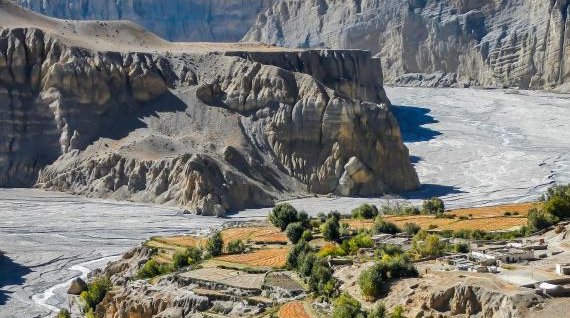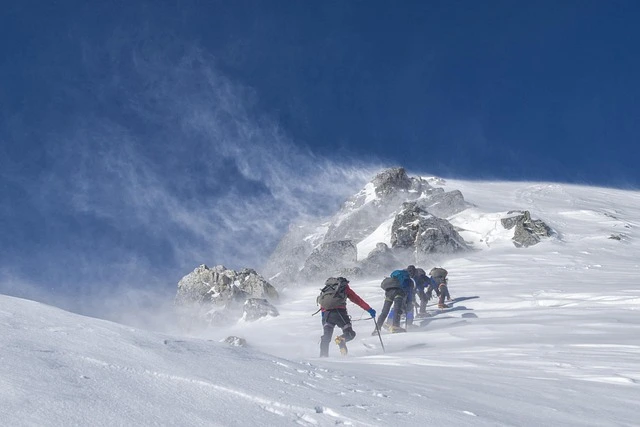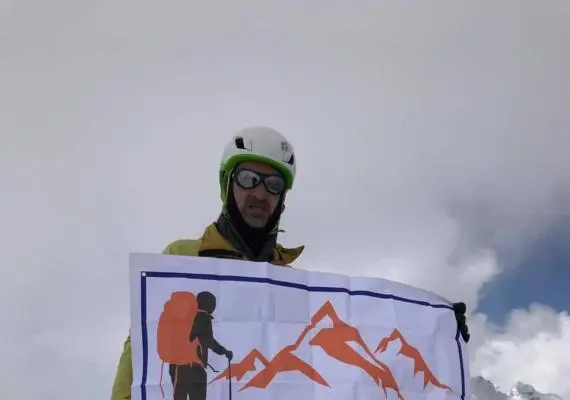The Lower Mustang Trek opens a window into one of Nepal's most culturally fascinating regions, where Tibetan Buddhist traditions thrive against a backdrop of dramatic desert landscapes. This moderate-difficulty journey takes you through the rain-shadow area of the Annapurna and Dhaulagiri ranges, revealing ancient monasteries, traditional villages, and landscapes that seem transported from another world entirely.
Unlike its restricted Upper Mustang counterpart, the Lower Mustang region welcomes independent trekkers with more accessible permits and budget-friendly options. From the medieval village of Kagbeni to the windswept plains near Muktinath, this trek combines cultural immersion with manageable altitudes (reaching approximately 3,800m), making it perfect for those seeking authentic Himalayan experiences without extreme physical demands or expensive restricted area permits.
Trip Highlights
- Explore Kagbeni's medieval architecture and ancient Buddhist monasteries
- Trek through dramatic desert-like landscapes unique in Nepal
- Visit Muktinath Temple, sacred to both Hindus and Buddhists
- Experience authentic Tibetan culture in traditional Mustang villages
- Walk sections of the ancient salt trade route between Tibet and India
- Discover mysterious caves carved into cliff faces
- Enjoy moderate trekking suitable for various fitness levels
- Stay in comfortable teahouses with local hospitality
- Witness spectacular views of Dhaulagiri and Nilgiri peaks
- Experience the unique Thakali culture and cuisine
- Visit apple orchards and taste famous Mustang apple brandy
- Budget-friendly trekking with standard ACAP/TIMS permits only
Short 16-Day Itinerary
- Day 1: Arrive Kathmandu (1,400m) - Transfer to hotel
- Day 2: Kathmandu sightseeing and trek preparation
- Day 3: Drive/fly Kathmandu to Pokhara (820m) - 6-7 hours drive or 25-minute flight
- Day 4: Fly Pokhara to Jomsom (2,743m), trek to Kagbeni (2,810m) - 3-4 hours
- Day 5: Kagbeni to Chele (3,050m) - 6-7 hours
- Day 6: Chele to Syangboche (3,475m) - 6-7 hours
- Day 7: Syangboche to Ghami (3,520m) - 5-6 hours
- Day 8: Ghami to Tsarang (3,560m) - 4-5 hours
- Day 9: Tsarang exploration day - Visit monastery and villages
- Day 10: Tsarang to Ghami (3,520m) - 4-5 hours
- Day 11: Ghami to Samar (3,290m) - 6-7 hours
- Day 12: Samar to Kagbeni (2,810m) - 5-6 hours
- Day 13: Kagbeni to Muktinath (3,710m) - 5-6 hours
- Day 14: Muktinath to Jomsom (2,743m) - 4-5 hours
- Day 15: Fly Jomsom to Pokhara, drive to Kathmandu
- Day 16: International departure
Why Choose the Lower Mustang Trek
The Lower Mustang Trek offers an exceptional balance of cultural richness, natural beauty, and accessibility that sets it apart from other Himalayan adventures. This region provides authentic experiences similar to Upper Mustang but without the hefty restricted area permit fees, making it an attractive option for budget-conscious travelers and those seeking flexibility in their trekking plans.
The moderate difficulty level opens this trek to a wider range of adventurers. With maximum altitudes around 3,800m, altitude sickness risks are significantly lower than on many popular Nepal treks. The well-established teahouse infrastructure means you can trek with just a daypack, enjoying comfortable evenings in local lodges rather than camping in tents.
What truly distinguishes the Lower Mustang Trek is its unique geography. The trans-Himalayan landscape creates an almost surreal environment where red cliffs tower above green oases, ancient caves dot the hillsides, and prayer flags flutter against impossibly blue skies. This rain-shadow region receives minimal precipitation, ensuring relatively stable weather conditions even during Nepal's monsoon season.
The cultural authenticity remains remarkably intact despite easier access. Villages along the route maintain traditional Tibetan Buddhist practices, and the influence of ancient trade routes between Tibet and India permeates daily life. You'll encounter genuine hospitality from local communities who welcome trekkers as guests rather than mere tourists.
Permits and Lower Mustang Trek Cost
One of the most appealing aspects of the Lower Mustang Trek is its straightforward permit requirements and reasonable costs. Unlike Upper Mustang's expensive restricted area permit, Lower Mustang requires only standard trekking permits:
Required Permits:
- ACAP (Annapurna Conservation Area Permit): NPR 3,000 (approximately USD 30)
- TIMS (Trekkers' Information Management System) Card: NPR 2,000 (approximately USD 20)
The total permit cost of just USD 50 makes this trek significantly more affordable than restricted area alternatives. These Mustang permits can be obtained in Kathmandu or Pokhara through registered trekking agencies or at tourist service centers.
Overall Lower Mustang Trek Cost Breakdown:
Budget Option (USD 800-1,200):
- Permits: USD 50
- Accommodation (teahouses): USD 5-10 per night
- Meals: USD 20-30 per day
- Guide (optional): USD 25-30 per day
- Porter (optional): USD 20-25 per day
- Transportation: USD 300-400
- Miscellaneous: USD 100-200
Standard Package (USD 1,200-1,800):
- All permits and paperwork
- Professional English-speaking guide
- Porter service (one porter per two trekkers)
- All meals during trek (breakfast, lunch, dinner)
- Teahouse accommodation throughout
- Domestic flights and ground transportation
- Basic first aid and emergency arrangements
Comfort Package (USD 1,800-2,500):
- Everything in standard package
- Better accommodation in cities
- More experienced senior guide
- Additional cultural activities
- Comprehensive travel insurance
- Welcome and farewell dinners
- Airport pickups and drops
The budget Lower Mustang trek option allows independent travelers to reduce costs significantly by arranging their own logistics, though having a guide enhances cultural understanding and safety.
Best Season for Lower Mustang Trek
Choosing the right season significantly impacts your Lower Mustang Trek experience. The region's unique position in the rain-shadow of the Himalayas creates distinct weather patterns that differ from other Nepal trekking areas.
Spring (March-May): The best season Lower Mustang offers clear skies, moderate temperatures, and rhododendron blooms in lower elevations. Daytime temperatures range from 10-20°C, with cooler nights. This season provides excellent mountain views and comfortable trekking conditions. The famous Tiji Festival in Upper Mustang (accessible with additional permits) usually occurs in May.
Autumn (September-November): Another peak season with stable weather, crystal-clear mountain views, and pleasant temperatures. Post-monsoon clarity reveals stunning vistas of Dhaulagiri and Annapurna ranges. This season sees more trekkers but maintains a peaceful atmosphere compared to busier routes like Everest Base Camp.
Summer/Monsoon (June-August): Unlike most Nepal treks, Lower Mustang remains accessible during monsoon due to minimal rainfall. While lower sections may receive some rain, the trans-Himalayan region stays relatively dry. This unique weather pattern makes it an excellent alternative when other areas are unsuitable for trekking.
Winter (December-February): Possible but challenging with temperatures dropping below freezing, especially at night. Some higher passes may have snow, and certain teahouses might close. However, you'll encounter few other trekkers and can experience the stark beauty of Mustang's winter landscape.
The stable weather conditions throughout much of the year make Lower Mustang Trek planning more flexible than many other Himalayan routes.
Accommodation and Food on the Trail
The teahouse Mustang trek experience combines comfort with cultural authenticity. Lower Mustang's well-developed lodge infrastructure ensures comfortable nights without the need for camping equipment, making the trek more accessible and affordable.
Teahouse Accommodation:
- Basic but clean rooms with twin beds
- Shared bathroom facilities (some lodges offer attached bathrooms)
- Common dining areas with heating (usually yak dung stoves)
- Blankets provided, but bringing a sleeping bag is recommended
- Hot showers available for small fee (USD 3-5)
- Charging facilities for electronics (USD 2-4 per device)
Food Options: The Mustang region offers surprisingly diverse cuisine considering its remote location:
- Traditional Nepali: Dal bhat (rice and lentils), unlimited refills
- Tibetan dishes: Momos (dumplings), thukpa (noodle soup), tingmo (steamed bread)
- Thakali cuisine: Regional specialty featuring buckwheat dishes and local vegetables
- Western options: Pasta, pizza, pancakes in larger villages
- Local specialties: Yak cheese, apple products, sea buckthorn juice
Meals typically cost USD 5-10 each, increasing slightly with altitude. Most trekkers find the food quality good and portions generous. Vegetarian options are always available and often recommended for better digestion at altitude.
Special Dietary Considerations:
- Inform lodges about allergies or dietary restrictions in advance
- Vegan and gluten-free options available but limited
- Carry snacks for trail energy (available in Jomsom and Kagbeni)
- Water purification tablets recommended to reduce plastic bottle waste
Fitness Level and Difficulty
The Lower Mustang Trek ranks as moderate in difficulty, making it accessible to reasonably fit individuals without requiring extreme physical preparation. Understanding the trek's demands helps ensure an enjoyable experience.
Physical Requirements:
- Daily walking: 4-7 hours on varied terrain
- Maximum altitude: 3,800m (Muktinath)
- Total distance: Approximately 120-140km
- Elevation gains: 300-600m per day average
Fitness Preparation: A basic fitness routine starting 6-8 weeks before the trek suffices:
- Cardio exercises: 30-45 minutes, 4-5 times weekly
- Hill walking or stair climbing with backpack
- Leg strengthening exercises
- Core stability work
- Practice hikes on weekends
Comparison to Other Treks: The Lower Mustang Trek is easier than:
- Everest Base Camp (lower altitude, shorter duration)
- Annapurna Circuit (no high passes over 5,000m)
- Manaslu Circuit (less remote, better infrastructure)
Similar difficulty to:
- Annapurna Base Camp trek
- Langtang Valley trek
- Lower Dolpo trek
Age Considerations: The moderate nature suits various age groups:
- Younger trekkers (12+) with family supervision
- Active seniors up to 70+ years
- Groups with mixed fitness levels
Altitude Considerations: The maximum altitude of 3,800m significantly reduces altitude sickness risks compared to higher treks. The itinerary includes gradual acclimatization, and most trekkers experience no serious altitude issues. Basic precautions include:
- Staying hydrated (3-4 liters daily)
- Walking at comfortable pace
- Avoiding alcohol
- Considering preventive medication if prone to altitude sickness
Cultural Experiences in Mustang
The cultural richness of the Lower Mustang Trek rivals its natural beauty. The region's position along ancient trade routes created a unique blend of Tibetan Buddhism, Bon traditions, and Hindu influences that persist today.
Tibetan Culture Mustang: The strong Tibetan influence manifests in:
- Architecture: Flat-roofed houses, narrow alleys, prayer wheels
- Religious practices: Daily prayers, butter lamp offerings, mantras
- Traditional dress: Chubas (robes) worn by older generations
- Language: Tibetan dialects alongside Nepali
Monasteries and Spiritual Sites:
- Kagbeni Monastery: 600-year-old structure with ancient scriptures
- Muktinath Temple: Sacred to Hindus and Buddhists, featuring eternal flame
- Village gompas: Small monasteries in each settlement
- Cave hermitages: Meditation retreats carved into cliffs
Cultural Villages Mustang: Each village offers unique experiences:
- Kagbeni: Medieval atmosphere with narrow alleys and ancient architecture
- Chele: Traditional farming community with terraced fields
- Syangboche: Spectacular views and traditional Tibetan houses
- Ghami: Ancient chortens and longest mani wall in Mustang
Festivals and Traditions:
- Local festivals throughout the year
- Harvest celebrations in autumn
- Buddhist ceremonies and masked dances
- Traditional wedding and funeral customs
Interaction Opportunities:
- Stay with local families in homestays
- Participate in daily prayers at monasteries
- Learn traditional crafts like weaving
- Share meals and stories with hosts
The authentic cultural encounters along the Lower Mustang Trek create lasting memories beyond the physical journey.
Logistics and Booking Options
Planning your Lower Mustang Trek involves choosing between independent trekking and organized packages, each offering distinct advantages.
Independent Trekking: Lower Mustang's accessibility makes solo or independent trekking feasible:
- Freedom to set your own pace and itinerary
- Direct booking with teahouses
- Flexibility to extend stays in favorite locations
- Significant cost savings possible
- Requires more pre-trip planning and navigation skills
Guided Trek Benefits:
- Cultural insights from knowledgeable local guides
- Pre-arranged accommodation ensuring availability
- Safety support and emergency protocols
- Porter service for comfortable trekking
- Language assistance in remote areas
Group Size Considerations:
- Small groups (2-6): More flexibility, personal attention
- Medium groups (7-12): Social atmosphere, shared costs
- Private treks: Customized itinerary, premium service
Booking Process:
- Choose trek dates based on season preferences
- Select budget level and service type
- Book 2-3 months in advance for peak seasons
- Confirm included services and exclusions
- Arrange travel insurance (mandatory)
- Prepare required documents (passport copies, photos)
Transportation Arrangements:
- Kathmandu to Pokhara: Tourist bus (USD 10-15) or flight (USD 100-130)
- Pokhara to Jomsom: Flight only (USD 110-140) - weather dependent
- Alternative: Overland via Beni (additional 2 days)
- Return options: Same route or extended trek variations
What to Look for in Operators:
- Government-registered company license
- Clear pricing with no hidden costs
- Experienced guides with first-aid training
- Good reviews from previous clients
- Proper insurance for staff
- Environmental responsibility practices
Extended Trek Variations
The Lower Mustang Trek offers flexibility for customization based on time and interests:
Shorter Options (7-10 days):
- Jomsom to Muktinath circuit
- Kagbeni and surrounding villages
- Cultural focus with less walking
Combined Treks:
- Lower Mustang + Annapurna Circuit
- Lower Mustang + Tilicho Lake
- Lower Mustang + Upper Mustang (with additional permits)
Special Interest Additions:
- Photography workshops
- Meditation retreats in monasteries
- Traditional medicine tours
- Geological expedition focus
Responsible Trekking Practices
Preserving Mustang's unique environment and culture requires conscious effort from all visitors:
Environmental Guidelines:
- Carry reusable water bottles with purification
- Pack out all non-biodegradable waste
- Use designated toilet facilities
- Avoid disturbing wildlife
- Stay on marked trails
- Respect sacred sites and monuments
Cultural Sensitivity:
- Dress modestly, especially near religious sites
- Ask permission before photographing people
- Remove shoes when entering monasteries
- Walk clockwise around religious monuments
- Avoid public displays of affection
- Learn basic Nepali greetings
Economic Impact:
- Buy local products and handicrafts
- Tip service staff appropriately
- Use local guides and porters
- Stay in locally-owned teahouses
- Avoid bargaining for basic services
Safety Considerations
While the Lower Mustang Trek is relatively safe, proper preparation ensures a worry-free journey:
Health Precautions:
- Comprehensive travel insurance with evacuation coverage
- First-aid kit with personal medications
- Water purification method
- Sun protection (high-altitude UV is intense)
- Altitude sickness awareness
Weather-Related Safety:
- Check flight conditions for Jomsom (frequent cancellations)
- Prepare for temperature variations
- Wind protection essential in afternoon
- River crossing safety during monsoon
Communication:
- Mobile network available in major villages
- Wi-Fi in some teahouses (paid service)
- Emergency evacuation procedures
- Register with embassy if trekking independently
Conclusion
The Lower Mustang Trek delivers an extraordinary Himalayan experience that balances cultural immersion, natural beauty, and accessibility. This moderate trek opens doors to ancient Tibetan Buddhist culture, dramatic desert landscapes, and authentic village life without the extreme physical demands or expensive permits of more challenging routes.
Whether you're drawn by the mystical monasteries, the unique trans-Himalayan terrain, or the opportunity to walk ancient trade routes, Lower Mustang offers experiences that linger long after you've returned home. The combination of comfortable teahouse accommodation, stable weather patterns, and reasonable costs makes this trek perfect for first-time Himalayan adventurers and seasoned trekkers alike.
Ready to explore the Lower Mustang Trek? Himalayan Hero Adventures specializes in crafting personalized Mustang experiences with expert local guides, proven safety records, and a commitment to responsible tourism. Our flexible itineraries and options for every budget ensure you'll have the trek of a lifetime while contributing positively to local communities.
Don't let another season pass without experiencing the magic of Mustang. Contact Himalayan Hero Adventures today to begin planning your journey to this remarkable corner of Nepal. The ancient kingdom of Mustang is calling – answer it with the experts who know it best!





